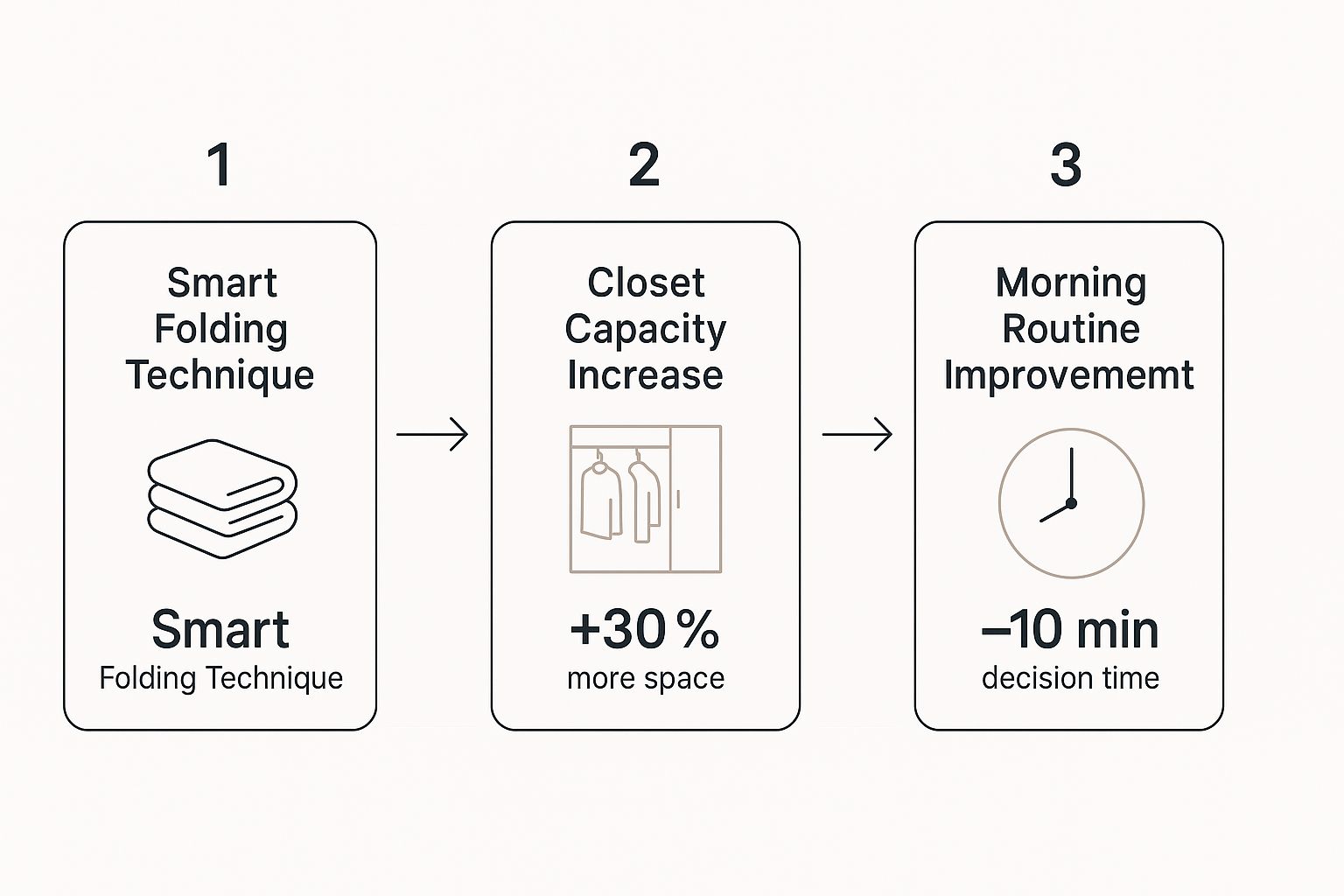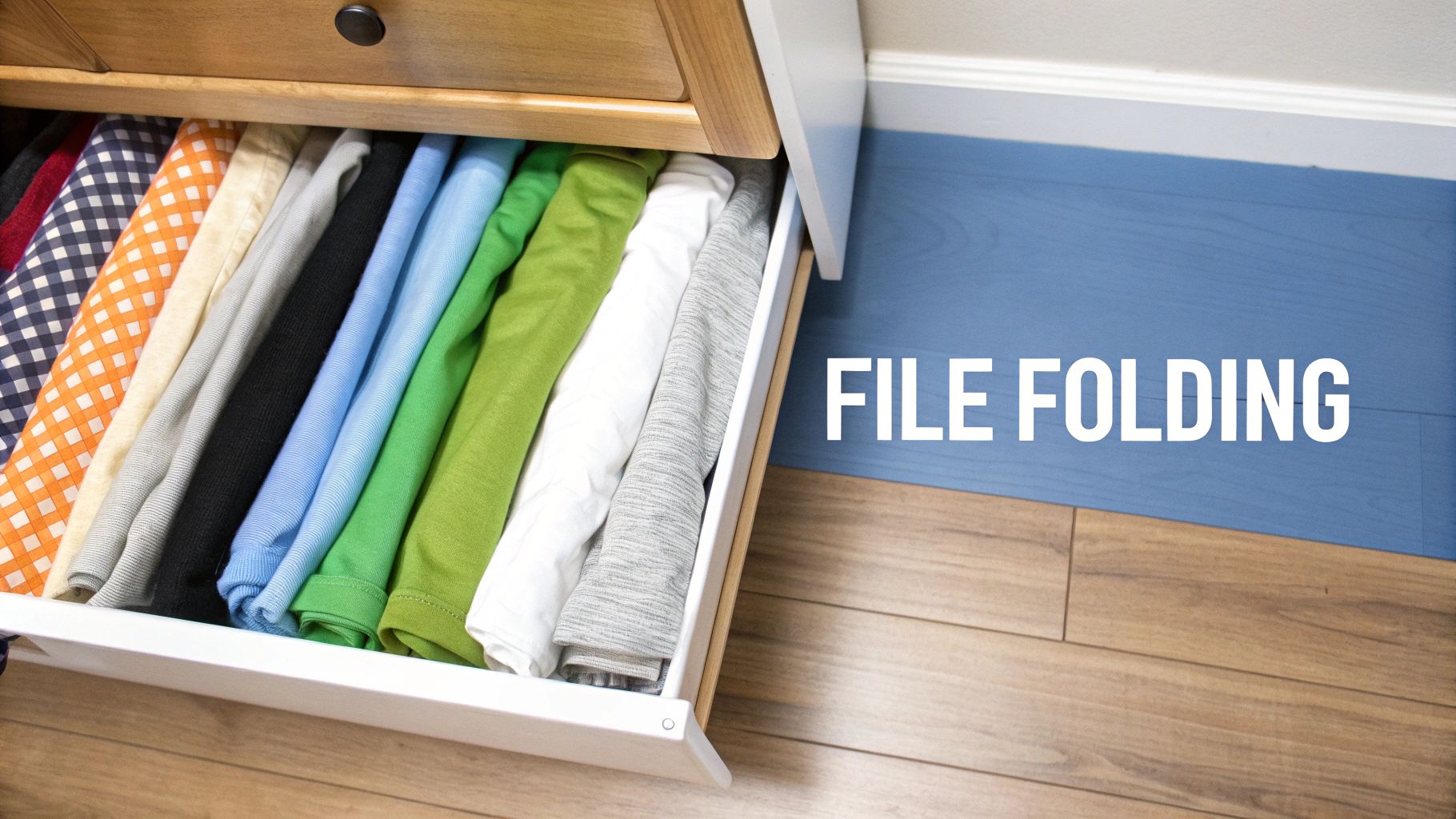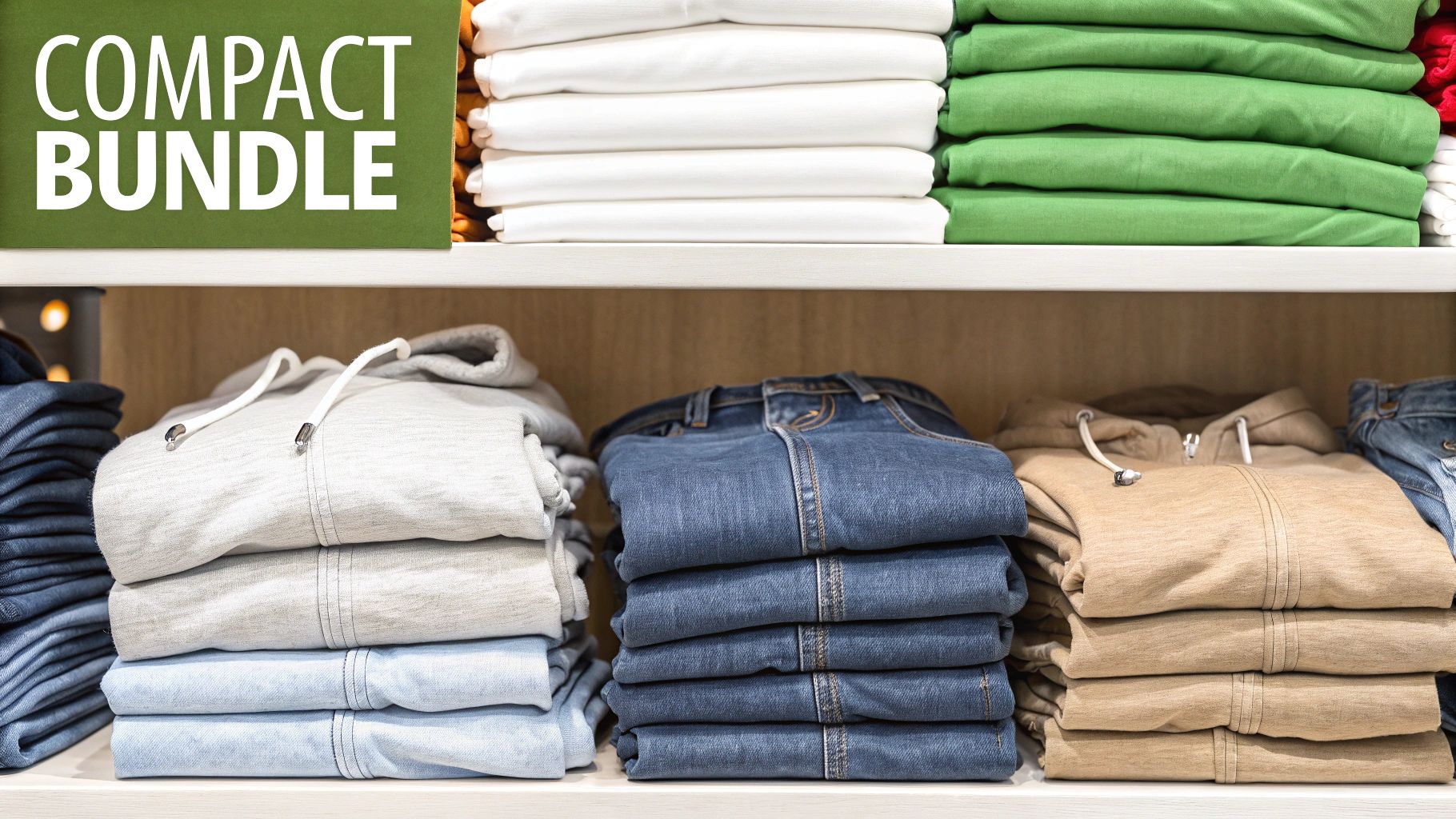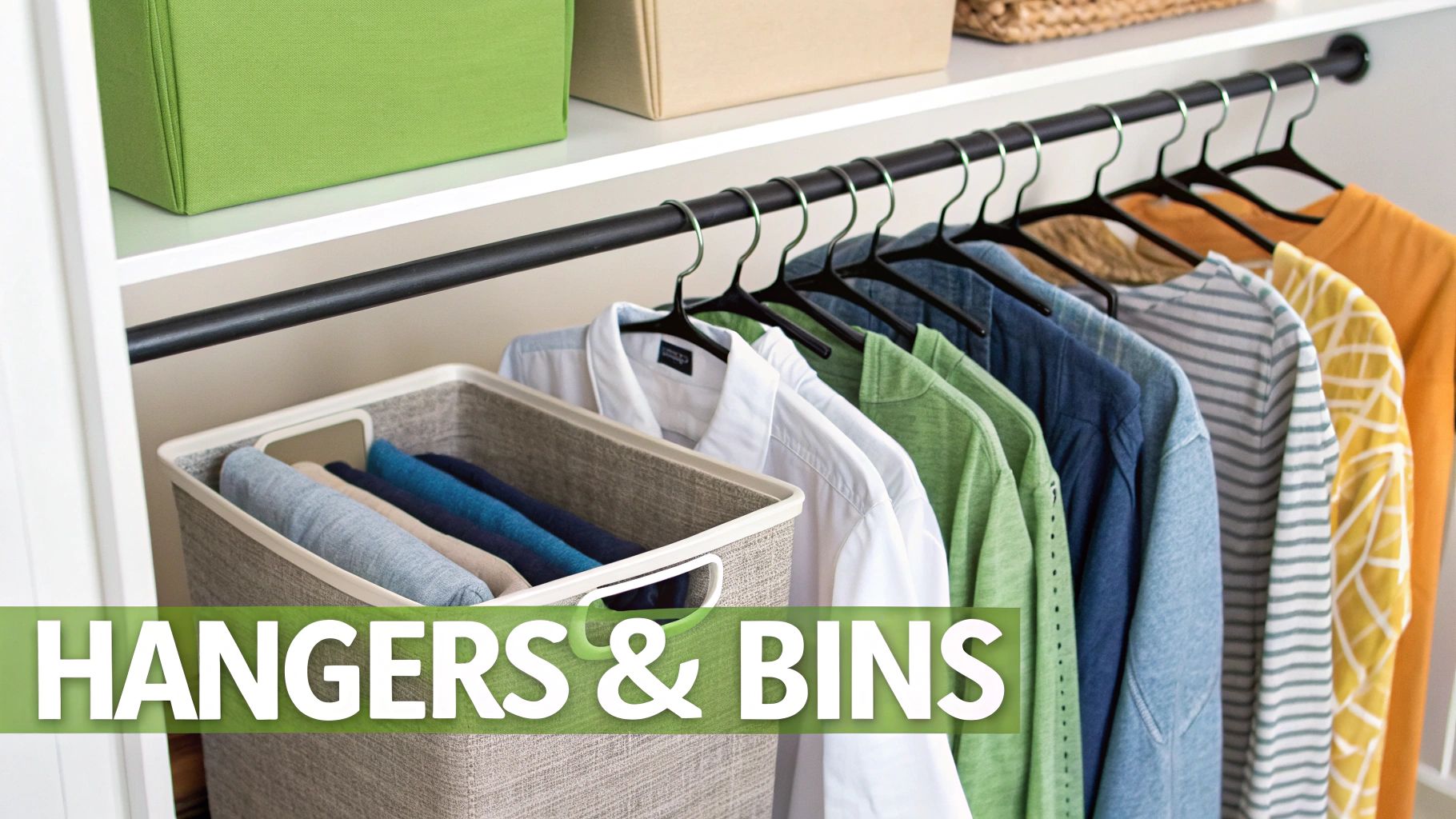Folding Clothes to Save Space and Organize Your Closet

We’ve all been there—staring into a closet that’s bursting at the seams, yet somehow, there’s nothing to wear. It’s a classic frustration, but the fix isn't necessarily a bigger closet. It’s about smarter organization. Learning how to fold clothes to save space can completely change your relationship with your wardrobe, turning daily closet chaos into calming order.
How a Simple Fold Can Unlock Your Closet's Potential
A messy closet is more than just a physical problem. It’s mental clutter. When clothes are haphazardly stuffed into drawers or crammed onto hangers, you can’t see what you own. You end up wearing the same few outfits on a loop simply because they’re the easiest to grab.
This is where strategic folding comes in. It’s the bedrock of any truly organized closet. Think of it less as a chore and more as a technique for reclaiming prime closet real estate. The idea is to create neat, uniform parcels that you can either stack neatly on a shelf or "file" vertically in a drawer, maximizing every inch of your space.
Once you get the hang of it, the benefits for your closet are immediate:
- You can actually see everything. When each item is folded and has its own spot, you can take in your entire collection with just a glance. No more digging.
- You'll create more room. A good fold can drastically shrink the footprint of your clothes, freeing up shelf and drawer space you didn't know you had.
- Mornings become a breeze. An organized closet means less time spent searching and more time for coffee. It just makes getting dressed simpler and less stressful.
Taking Back Your Wardrobe Space
The difference a consistent folding routine makes is genuinely surprising. Homes that stick to a regular folding system save an average of 37% more wardrobe space than those that don't. Think about it this way: in a typical wardrobe, unfolded clothes can easily eat up 65% of your shelf space, whereas neatly folded items might only take up 34%. If you’re a visual learner, this detailed video on home organization offers some fantastic insights.
I’ve found that switching from messy piles to structured folds is the fastest way to make a real, visible improvement in a closet. It isn’t about achieving perfection—it’s about building a simple system that brings a little calm back into your daily routine.
The right folding method can feel like a magic trick, instantly creating more room. It's not just about what you fold, but how you fold it to fit your closet's layout.
Folding Method vs Closet Space Gained
Here's a quick look at how different folding styles stack up and what closet spaces they’re best for.
| Folding Method | Best For | Estimated Space Saved |
|---|---|---|
| KonMari (Vertical File Fold) | Drawers, t-shirts, jeans | Up to 50% |
| Ranger Roll (Military Roll) | Traveling, gym clothes, socks | Up to 40% |
| Basic Flat Fold | Shelves, sweaters, bulky items | Up to 30% |
| Hanging Fold | Trousers, delicate blouses | Varies (best for wrinkle prevention) |
Choosing the right technique for each item is key to maximizing every inch of your closet storage.
The infographic below really brings home how a small change in your folding habits can have a huge impact on your closet's capacity and your morning routine.

As you can see, a simple shift in how you handle your laundry creates a ripple effect, unlocking more space and saving you precious time.
Mastering Folds for T-Shirts and Sweaters
Let's be honest, the foundation of any well-organized closet starts with the basics: t-shirts and sweaters. If they’re not handled right, they create those messy, unstable piles that topple over and hide half your wardrobe. But a little technique goes a long way, turning them into the building blocks of a truly clutter-free space.

This shift from chaotic piles to orderly rows isn't some new trend. As living spaces got smaller during the 20th century, especially in big cities, smart folding became less of a chore and more of a survival skill. Think about Tokyo, where the average apartment in 2020 was a tiny 590 square feet. It’s no surprise that surveys found 65% of households there were already experts at folding clothes to save space.
Doing it right can actually shrink a stack of clothes by up to 50%, which is a huge gain in a tight closet. You can dig deeper into the benefits of strategic folding to see just how much of a difference it makes.
The Game-Changing T-Shirt File Fold
For t-shirts, the single best thing you can do for your drawers is stop stacking them flat and start "filing" them vertically. This little change is huge. It lets you see every single shirt you own at a glance, so you're not digging through a pile and wrecking all your hard work just to find that one band tee.
The whole idea is to turn each shirt into a compact, self-standing rectangle. Just lay the shirt flat, bring both sides inward to the middle to form a long rectangle, and then fold that rectangle into thirds. The final little packet should be sturdy enough to stand up on its own in your drawer.
The real secret to making the file fold work? Consistency. Try to make every folded shirt the same width. That uniformity is what creates the clean, satisfying look in your drawers and makes finding what you need completely effortless.
Conquering Bulky Sweaters Without Damage
Sweaters are a different beast. They're bulky, and the knits are often delicate. One of the worst things you can do is hang a heavy sweater—it’s a surefire way to get a stretched-out neckline and those dreaded shoulder bumps. The best approach is a fold that protects the sweater's shape while also making it easy to stack on a closet shelf.
Here’s a technique I’ve used for years that works like a charm:
- First, lay the sweater face down on a clean, flat surface.
- Next, fold each arm straight across the back of the sweater. You should have a nice, clean rectangular shape now.
- Then, fold the sweater in half from the bottom up, bringing the hem right up to the collar.
- For really thick sweaters, you can fold it in half one more time. This creates an even more compact and stable square that's perfect for stacking.
This method puts zero stress on the collar and gives you a uniform shape that sits beautifully on a shelf. You can easily stack three or four sweaters this way without the pile getting wobbly. This is my go-to strategy for folding clothes to save space, especially when putting away my winter wardrobe.
Common Folding Mistakes to Avoid
Even if you know the right technique, a few common mistakes can undo all your organizing efforts. Keep an eye out for these little things to make sure your closet stays in top shape.
- Folding too loosely: A floppy fold won't hold its shape. Your items will just fall over in the drawer or unravel on the shelf. Keep your folds firm and crisp.
- Ignoring the fabric: Delicate knits need a lighter touch than sturdy cotton. You don't want to force a thick wool sweater into a super-tight fold, as it can damage the fibers over time.
- Creating inconsistent sizes: If all your folded clothes are different shapes and sizes, they just won't stack or file well. The goal is uniformity—it's what makes the system functional and look great in your closet.
Smart Ways to Fold Pants and Bulky Clothes
Now that you’ve gotten the hang of folding t-shirts and sweaters, it’s time to tackle the real space hogs in your closet: pants and bulky outerwear. Let's be honest, these are the items that usually end up in lumpy, disorganized piles on shelves. But with the right folding strategy, you can transform that chaos into clean, accessible stacks.

The idea of folding for maximum efficiency isn't just a modern organization hack. History is full of great examples. Think about World War II, when U.S. soldiers had to cram all their gear into a standard footlocker that was only 2.5 cubic feet. Or the British Royal Navy's 1950s sea manual, which taught sailors a specific trouser fold that slashed the space needed for each pair by up to 60%. You can see some of these historical space-saving methods and realize we’re just adapting them for our closets today.
How to Fold Jeans for Perfect Stacks
We all have them, and their bulky denim can be a storage nightmare. The goal here is simple: turn your jeans into a compact, self-contained rectangle that can be stacked neatly on a shelf or filed vertically in a deep drawer without falling over.
Here’s a tried-and-true method that turns a clumsy pair of jeans into a tidy package:
- First, lay the jeans on a flat surface and fold one leg right over the other.
- Next, tuck the crotch area inward. This is a small but crucial step that creates a straight, rectangular edge to work with.
- Fold the jeans in half from the bottom, bringing the cuffs all the way up to the waistband.
- Finally, fold them in half one last time. You'll be left with a thick, stable rectangle that sits perfectly on a shelf.
This is my go-to technique for folding clothes to save space because it makes your denim stacks look uniform and sturdy. No more jean avalanches when you pull a pair from the bottom!
A consistent fold is the key to visual harmony in your closet. When all your jeans are folded to the same dimensions, your shelves instantly look cleaner and more organized, which makes getting dressed a much calmer experience.
Folding Dress Pants and Trousers to Avoid Creases
Dress pants are a different animal entirely. The main priority is preventing wrinkles and sharp, unwanted creases, so the tight, compact fold we use for jeans is out of the question. For these, you need a much softer touch, whether you’re putting them in a drawer or on a hanger.
If you’re storing them in a drawer, a gentle roll or a loose tri-fold is your best bet. Just lay the pants flat, align the legs, and fold them into thirds. This prevents that harsh crease from forming right down the middle of the leg.
Honestly, though, for most dress trousers, hanging is the best way to keep them wrinkle-free. To make the most of your hanging space, you can use a tiered space-saving pant hanger that lets you hang multiple pairs vertically.
Taming Bulky Hoodies and Sweatshirts
Hoodies and sweatshirts might just be the most awkward items to store. Between the bulky hoods and long arms, they almost seem designed to create a mess. The trick is to use the hoodie itself to contain all its unruly parts.
Here’s how I do it:
- Lay the hoodie face down on a flat surface.
- Fold the arms horizontally across the back.
- Next, fold the sides of the body inward to create a long rectangle.
- From there, fold the bottom hem up toward the hood.
- Now for the magic part: tuck the entire folded body neatly into the hood.
This creates a tidy, self-contained package with no loose sleeves or strings. It’s perfect for stacking on a high closet shelf and turns a lumpy mess into an organized asset.
Bringing It All Together: Hangers, Bins, and a Perfectly Organized Closet
Folding your clothes perfectly is a great start, but it's only half the battle. To really conquer closet chaos, you need a system that combines smart folding with the right storage tools. It’s all about creating a cohesive strategy where folding, hanging, and binning work in harmony.
This isn't just about cramming more stuff in; it’s about making strategic choices that protect your clothes and make every single inch of your closet functional.

The first decision you have to make is simple but crucial: what gets folded, and what gets hung up? Getting this right can prevent stretched-out shoulders and stubborn creases, making your morning routine a whole lot easier.
- Always Hang These: Think blazers, dress pants, and anything delicate like silk or chiffon blouses. Folding these can set permanent wrinkles and completely ruin their shape.
- Perfect for Folding: Sturdy items are your best bet here. T-shirts, denim, and chunky sweaters do really well when folded. In fact, hanging heavy knitwear can cause the neck and shoulders to stretch out over time, so folding is a much better option.
By making this simple distinction, you’re not only preserving your clothes but also making sure you're folding clothes to save space in the areas where it has the biggest impact—your drawers and shelves.
Go Vertical with Space-Saving Hangers
Once you've got your "to-hang" pile sorted, the next step is to make your hanging space work harder. A standard closet rod fills up surprisingly fast, but you can instantly multiply its capacity by thinking vertically. This is where multi-garment hangers become your best friend.
A single tiered hanger, for example, can hold five pairs of pants in the same vertical footprint as a single, traditional hanger. That’s a game-changer. The same concept works wonders for tank tops, skirts, and scarves. Using these instantly frees up so much horizontal rod space, making your closet feel twice as big and way less cluttered.
And when those hangers aren't in use? It pays to know a few tricks for how to store hangers so they don't end up in a tangled mess at the bottom of your closet.
Use Bins and Dividers to Keep Folds in Check
So, you've mastered the perfect t-shirt fold. Now what? Just stacking them on a deep shelf is a recipe for disaster. The minute you try to pull one out from the bottom of the pile, the whole thing topples over. This is where containers save the day.
The secret to keeping your folded clothes neat is to give them boundaries. Bins and dividers are what stop your perfect stacks from turning back into messy piles.
I love using fabric bins on shelves to group categories together. You can have one for workout gear, another for pajamas, and one for sweatshirts. This creates a simple "grab and go" system that lets you find what you need without messing everything else up.
For drawers, adjustable dividers are non-negotiable. They create little compartments that keep your file-folded clothes standing upright, turning a jumbled drawer into a tidy, visual library of your wardrobe. This is the final piece of the puzzle that ensures your closet stays beautifully organized for good.
Maintaining Your Newly Organized Closet Long Term
https://www.youtube.com/embed/X-aQUn--ijg
You’ve put in the work—all that sorting, folding, and organizing is done. Fantastic. But now comes the real test: keeping it that way for good. A truly organized closet isn’t a one-and-done project. It’s the result of a few simple habits that stop clutter from slowly creeping back in.
The most powerful habit is also the most straightforward: put your clean laundry away immediately. Don't let that basket of clean clothes become a permanent piece of furniture in your bedroom. The moment everything is dry, take those ten minutes to fold your clothes properly and put them back where they belong. This one little routine prevents the dreaded "floordrobe" from ever taking hold.
Adopt the One-In, One-Out Rule
So, what’s the biggest cause of closet chaos? Simple accumulation. We bring new things in, but the old things never leave. The easiest way I’ve found to combat this is the “one-in, one-out” rule.
Whenever you buy a new shirt, an old one has to go. New pair of jeans? An old pair gets donated. This simple exchange keeps your closet from overflowing and makes you much more intentional about your purchases. It forces you to constantly ask what you really love and wear.
If you get stuck on what to part with, our guide on how to declutter your closet has some great, practical steps to make those choices less painful.
A tidy closet is a direct result of small, consistent actions. It’s not about finding hours for a massive overhaul; it's about spending a few minutes each day to maintain order.
Perform a Seasonal Wardrobe Swap
Let's be realistic—you don't need your heavy winter parka taking up prime real estate in July. Storing off-season clothes is a game-changer for making your closet feel spacious and relevant to your daily life. Just set aside an hour twice a year to do the swap.
- The Spring Swap: Time to pack away the heavy sweaters, bulky coats, and thermal gear. Bring all your dresses, shorts, and lightweight tops to the forefront.
- The Autumn Swap: Say goodbye to summer clothes for a few months and welcome back all your cozy knits, flannels, and jackets.
This ritual does more than just free up valuable hanger space. It's a natural checkpoint. As you're packing things away, you can inspect for any damage, pull out items to donate, and make a mental note of what you might need for the season ahead. It’s a built-in maintenance plan that keeps your closet perfectly tuned to the here and now. Sticking to these strategies will make sure all your hard work folding clothes to save space really lasts.
Of course. Here is the rewritten section, designed to sound like it was written by an experienced human expert.
Your Top Folding and Closet Space Questions, Answered
Even after you’ve nailed the best folding techniques, a few questions always seem to pop up. Trust me, I’ve heard them all. Getting these little details sorted out is what makes the difference between a closet that looks organized for a week and one that stays that way for good.
Let's clear up some of the most common hangups.
Is It Better to Roll or Fold Clothes?
Ah, the great debate. The honest answer? It really depends on what you're doing.
Rolling is an absolute game-changer for packing a suitcase. I never travel without rolling my t-shirts, workout clothes, and anything made of jersey or knit fabric. It squeezes them into tight little logs, letting you cram way more into your luggage.
But for your drawers and shelves at home? A good, flat fold is almost always the better choice. Folded clothes create neat, even stacks that sit perfectly on a shelf. Trying to stack rolled sweaters is a recipe for a wobbly, disorganized mess that will just fall over. A solid fold gives your clothes structure.
How Can I Stop My Folded Clothes From Falling Over?
We’ve all been there. You pull out one shirt, and the whole perfect stack comes tumbling down. It's beyond frustrating. The fix here is two-fold: technique and support.
First, your file fold needs to be tight and consistent. You’re aiming for a compact little rectangle that can practically stand up on its own.
The real secret isn't just the fold—it's about creating a snug fit. Get some adjustable drawer dividers. They let you create custom-sized compartments, eliminating the empty space that lets everything slide around and collapse.
What Clothes Should I Absolutely Never Fold?
Folding is a superpower for saving space, but it's not the right move for every piece in your wardrobe. For some items, folding is a one-way ticket to damage and permanent creases.
Here's my non-negotiable "always hang" list:
- Structured Blazers and Jackets: Folding will absolutely wreck their shape, creating weird, permanent wrinkles in the shoulders and lapels.
- Anything Delicate: Think silk, chiffon, or lace. These fabrics are just begging to get snagged or wrinkled in a drawer. Keep them safe on a hanger.
- Formal Trousers: To keep that sharp, professional crease down the leg, dress pants need to be hung. A proper pant hanger that won't leave clamp marks is your best friend here.
Deciding what to fold and what to hang is just as important as how you fold. Knowing what to leave on the hanger will save you space and save your clothes.
Ready to take your closet from cluttered to calm? The right tools can change everything. Check out the full collection of space-saving solutions from MORALVE and see how our innovative hangers can help you finally win back your space. Start organizing today at MORALVE.com.


Leave a comment